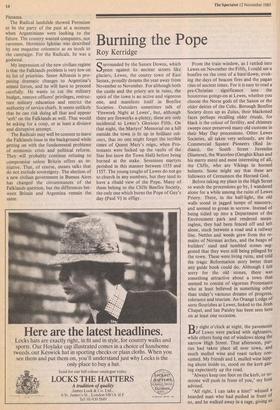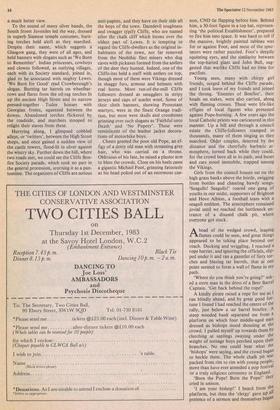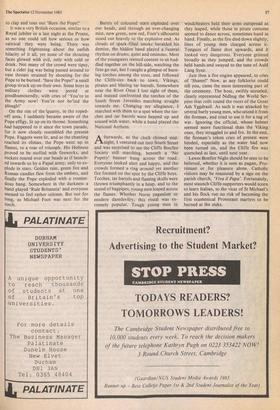Burning the Pope
Roy Kerridge
Surrounded by the Sussex Downs, which press against its ancient streets like glaciers, Lewes, the county town of East Sussex, proudly dreams the year away from November to November. For although both the castle and the priory are in ruins, the spirit of the town is an active and vigorous one, and manifests itself in Bonfire Societies. Outsiders sometimes talk of 'Firework Night at Lewes', but, although there are fireworks a-plenty, these are only incidental to Lewes's Glorious Fifth. On that night, the Martyrs' Memorial on a hill outside the town is lit up in brilliant col- ours, that no one might forget the terrible times of Queen Mary's reign, when Pro- testants were locked up the vaults of the Star Inn (now the Town Hall) before being burned at the stake. Seventeen martyrs perished in this manner between 1555 and 1557. The young toughs of Lewes do not go to church in any numbers, but they tend to have a ribald view of the Pope. Many of them belong to the Cliffe Bonfire Society, the only one which burns the Pope of Guy's day (Paul V) in effigy. From the train window, as I rattled into Lewes on November the Fifth, I could see a bonfire on the crest of a bare down, evok- ing the days of beacon fires and the pagan rites of ancient times. For it is easy to read a pre-Christian significance into the boisterous goings-on at Lewes, whether you choose the Norse gods of the Saxon or the older deities of the Celts. Borough Bonfire Society dress up as Zulus, their blackened faces perhaps recalling older rituals, for black is the colour of fertility, and chimney sweeps once preserved many old customs in their May Day processions. Other Lewes Societies, all taken very seriously, are the Commercial Square Pioneers (Red In- dians), the South Street Juveniles (Siamese), the Waterloo (Genghis Khan and his merry men) and most interesting of all, the Cliffe, who are Vikings in horned helmets. Some might say that these are followers of Cernunnos the Horned God.
Before taking my place in the High Street to watch the processions go by, I wandered alone for a while among the ruins of Lewes Priory. There, in the half-light, the old walls stood in jagged lumps of masonry, and seemed to groan in sorrow. Instead of being tidied up into a Department of the Environment park and rendered mean- ingless, they had been fenced off and left alone, stuck between a road and a railway line. Nettles and weeds grew from the re- mains of Norman arches, and the heaps of builders' sand and tumbled stones sug- gested that they were still being pillaged by the town. These were living ruins, and told the tragic Reformation story better than any guide book could do. Although I felt sorry for the old stones, there was something attractive about a town that seemed to consist of vigorous Protestants who at least believed in something other than today's vacuous dreams of progress, tolerance and tourism. An Orange Lodge of sorts flourishes at Lewes, linked to the Jireh Chapel, and Ian Paisley has been seen here on at least one occasion.
By eight o'clock at night, the pavements of Lewes were packed with sightseers, while others hung out of windows along the narrow High Street. That afternoon, par- ties had taken place all over town, and much mulled wine and roast turkey con- sumed. My friends and I, mulled wine lapp- ing about inside us, stood on the kerb gaz- ing expectantly up the road.
'Always keep one foot on the kerb, or so- meone will push in front of you,' my host advised.
'All right, I can take a hint!' whined a bearded man who had pushed in front of us, and he walked away in a rage, giving us a much better view.
To the sound of many silver bands, the South Street Juveniles led the way, dressed in superb Siamese temple costumes, burn- ing torches held aloft as they marched. Despite their name, which suggests a Glasgow gang, they were of all ages, and held banners with slogans such as 'We Burn to Remember'. Indian princesses, cowboys and clowns followed, as outlying villages, each with its Society standard, joined in, glad to be associated with mighty Lewes. 'We Burn for Good' read Crowborough's slogan. Burning tar barrels on wheelbar- rows and flares from the oil-rag torches lit up the ancient High Street and its narrow pressed-together Tudor houses with Georgian fronts, squeezed between the downs. Abandoned torches flickered by the roadside, and marchers stooped to relight their staves from these.
Hurrying along, I glimpsed cobbled alleys, or 'twitters', between the High Street shops, and once gained a sudden view of the castle towers, flood-lit in silver against the wintry sky. Further down the hill, where two roads met, we could see the Cliffe Bon- fire Society parade, which took no part in the general procession, scorning it as a pan- tomime. The organisers of Cliffe are serious anti-papists, and they have on their side all the boys of the town, Daredevil toughness and swagger typify Cliffe, who are named after the chalk cliff which looms over the oldest part of Lewes. It is tempting to regard the Cliffe-dwellers as the original in- habitants of the town, not far removed from the Neolithic flint miners who dug caves with pickaxes formed from the antlers of the deer they hunted. Indeed, one of the Cliffe-ites held a staff with antlers on top, though most of them were Vikings dressed in shaggy furs, armour and helmets with real horns. More run-of-the-mill Cliffe followers dressed as smugglers in stripy jerseys and caps of scarlet wool. Some of their cloth banners, showing Protestant martyrs, were in the finest Orange tradi- tion, but most were skulls and crossbones grinning over such slogans as 'Faithful unto Death' and `No Popery'. These were reminiscent of the leather jacket decora- tions of motorbike boys.
Cheers greeted the poor old Pope, an ef- figy of a dotty old man with streaming grey hair, who was carried on a throne. Oblivious of his fate, he raised a plaster arm to bless the crowds. Close on his heels came a gigantic Michael Foot, grinning fatuously as his head poked out of an enormous can-
non, CND tie flapping before him. Behind him, a 30-foot figure in a top hat, represen- ting 'the political Establishment', prepared to fire him into space. It was hard to tell if the massive, brightly painted tableau was for or against Foot, and most of the spec- tators were rather puzzled. Foot's sleepily squinting eyes, and the similarity between the top-hatted giant and John Bull, sug- gested that warlike Cliffe had no time for pacifists.
Young men, many with chirpy girl friends, surged behind the Cliffe parade, and I took leave of my friends and joined the throng. 'Enemies of Bonfire', their heads on stakes, were also carried, along with flaming crosses. These were life-like effigies of local figures who protested against Pope-burning. A few years ago the local Catholic priests was caricatured in this manner. Up a hill and through a council estate the Cliffe-followers tramped in thousands, many of them singing as they marched. Older couples, deterred by the distance and the cheerfully barbaric at- mosphere, turned back while they could, for the crowd bore all in its path, and buses and cars stood immobile, trapped among the Vikings.
Girls from the council houses sat on the high grass banks above the horde, swigging from bottles and chanting bawdy songs. 'Seagulls! Seagulls!' roared one gang of youths in our midst, supporters of Brighton and Hove Albion, a football team with a seagull emblem. The atmosphere remained jovial until we reached the bottleneck en- trance of a disused chalk pit, where everyone got stuck.
Ahead of the wedged crowd, leaping flames could be seen, and great things appeared to be taking place beyond our reach. Ducking and wriggling, I reached a rope barrier, and ignoring the officials, slip- ped under it and ran a gauntlet of fiery tor- ches and blazing tar barrels, that at one point seemed to form a wall of flame in my path.
'Where do you think you're going?' ask- ed a stern man in the dress of a Beer Barrel Captain. 'Get back behind the rope!'
A kindly pirate raised a rope for me as I ran blindly ahead, and by great good for- tune I found I had reached the centre of the rally, just below a tar barrel bonfire. A steep wooded bank separated me from a platform on which four middle-aged men dressed as bishops stood shouting at the crowd. I pulled myself up towards them bY clutching at saplings swaying under the weight of teenage boys perched upon their branches. No one could hear what the 'bishops' were saying, and the crowd began to heckle them. The whole chalk pit was packed from rim to rim with young peoPle, more than have ever attended a pop festival or a truly religious ceremony in England.
'Burn the Pope! Burn the Pope!' theY cried in unison.
'I am your bishop!' I heard from the, platform, but then the 'clergy' gave up all pretence of a sermon and themselves began
to clap and roar out 'Burn the Pope!'
It was a very British occasion, similar to a Royal jubilee Or a last night at the Proms, as no one could tell how serious or how satirical they were being. There was something frightening about the oafish hilarity of it all, yet none of the shouting faces glowed with evil, only with cold or drink. Not many of the crowd were tipsy, but a cider jug was being passed around to ease throats strained by shouting for the Pope to be burned. 'Save the Pope!' a small group struck up on their own. Some boys in military clothes were jeered at goodhumouredly, with cries of 'You're in the Army now! You're not be'ind the plough!'
On the rim of the 'quarry, in the roped- off area, I suddenly became aware of the Pope effigy, lit up on its throne. Something had happened to it since the town parade, for it now closely resembled the present Pope. Faggots were lit, and as the chanting reached its climax, the Pope went up in flames, to a roar of triumph. His Holiness proved to be stuffed with fireworks, and rockets roared over our heads as if launch- ed towards us by a Papal army, only to ex- plode in stars. Golden rain, green fire and Roman candles flew from the embers, and finally the Pope exploded with a tremen- dous bang. Somewhere in the darkness a band played 'Rule Britannia' and everyone seemed to feel rather solemn. But not for ong, as Michael Foot was next for the torch. Bursts of coloured stars exploded over our heads, and through an ever-changing mist, now green, now red, Foot's silhouette stood out bravely to the explosive end. As clouds of spark-filled smoke heralded his demise, the hidden band played a funeral rhythm on drums, quiet and ominous. Most of the youngsters seemed content to sit hud- dled together on the hill-side, watching the fires go out, but I caught a glimpse of burn- ing torches among the trees, and followed the Cliffe-ites back to town, Vikings, pirates and blazing tar barrels. Somewhere near the River Ouse I lost sight of them, and instead confronted the torches of the South Street Juveniles marching straight towards me. Changing my allegiance, I marched with them to a spot where the tor- ches and tar barrels were heaped up and soused with water, while a band played the National Anthem.
Afterwards, as the clock chimed mid- night, I ventured out into South Street and was surprised to see the Cliffe Bonfire Society still marching, beneath a `No Popery' banner hung across the road. Everyone looked alert and happy, and the crowds formed a ring around yet another fire formed on the spot by the Cliffe boys. Torches, tar barrels and flaming skulls were thrown triumphantly in a heap, and to the sound of bagpipes, young men leaped across the flames. Whether Norse paganism or modern daredevilry, this ritual was ex- tremely popular. Tough young men in
windcheaters held their arms outspread as they leaped, while those in pirate costume seemed to dance across, sometimes hand in hand. Finally, as the fire died down slightly, lines of young men charged across it. Tongues of flame shot upwards, and it looked very dangerous. Everyone grinned broadly as they jumped, and the crowds held hands and swayed to the tune of Auld Lang Syne.
Just then a fire engine appeared, to cries of 'Shame!' Now, as any folklorist could tell you, came the most interesting part of the ceremony. The hose, swiftly unreeled, clearly represented Nidhug the World Ser- pent that coils round the roots of the Great Ash Yggdrasil. As such it was attacked by several burly young men, who seized it from the fireman, and tried to use it for a tug of war. Ignoring the official, whose helmet seemed more functional than the Viking ones, they struggled to and fro. In the end, the fireman's token cries of protest were heeded, especially as the water had now been turned on, and the Cliffe fire was quenched as last, until next year.
Lewes Bonfire Night should be seen to be believed, whether it is seen as pagan, Pro- testant or for pleasure alone. Catholic visitors may be reassured by a sign on the parish church, Viva ii Papa'. Fortunately, most staunch Cliffe-supporters would scorn to learn Italian, so the vicar of St Michael's and his flock run no risk of becoming the first ecumenical Protestant martyrs to be .burned at the stake.
















































 Previous page
Previous page